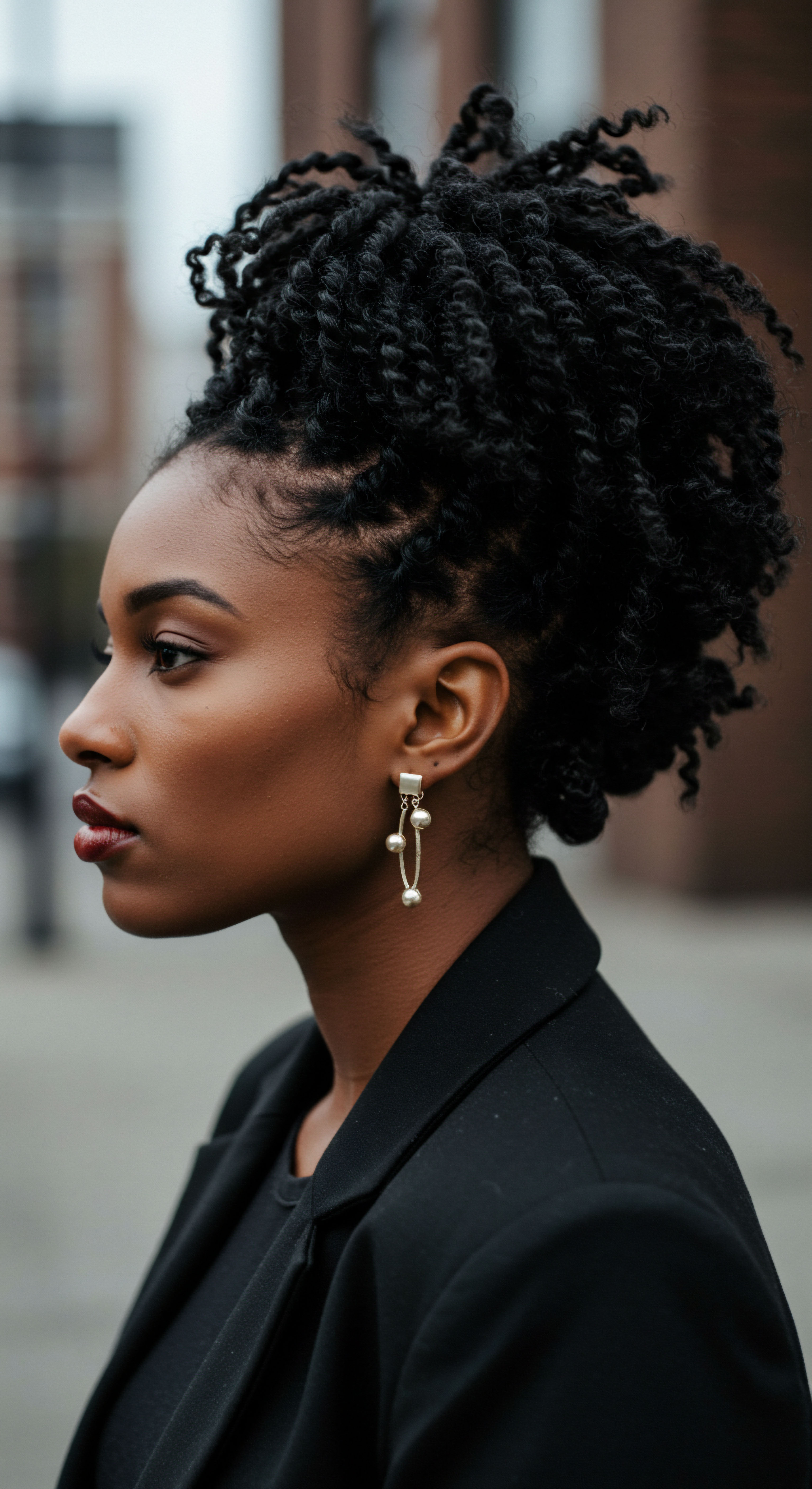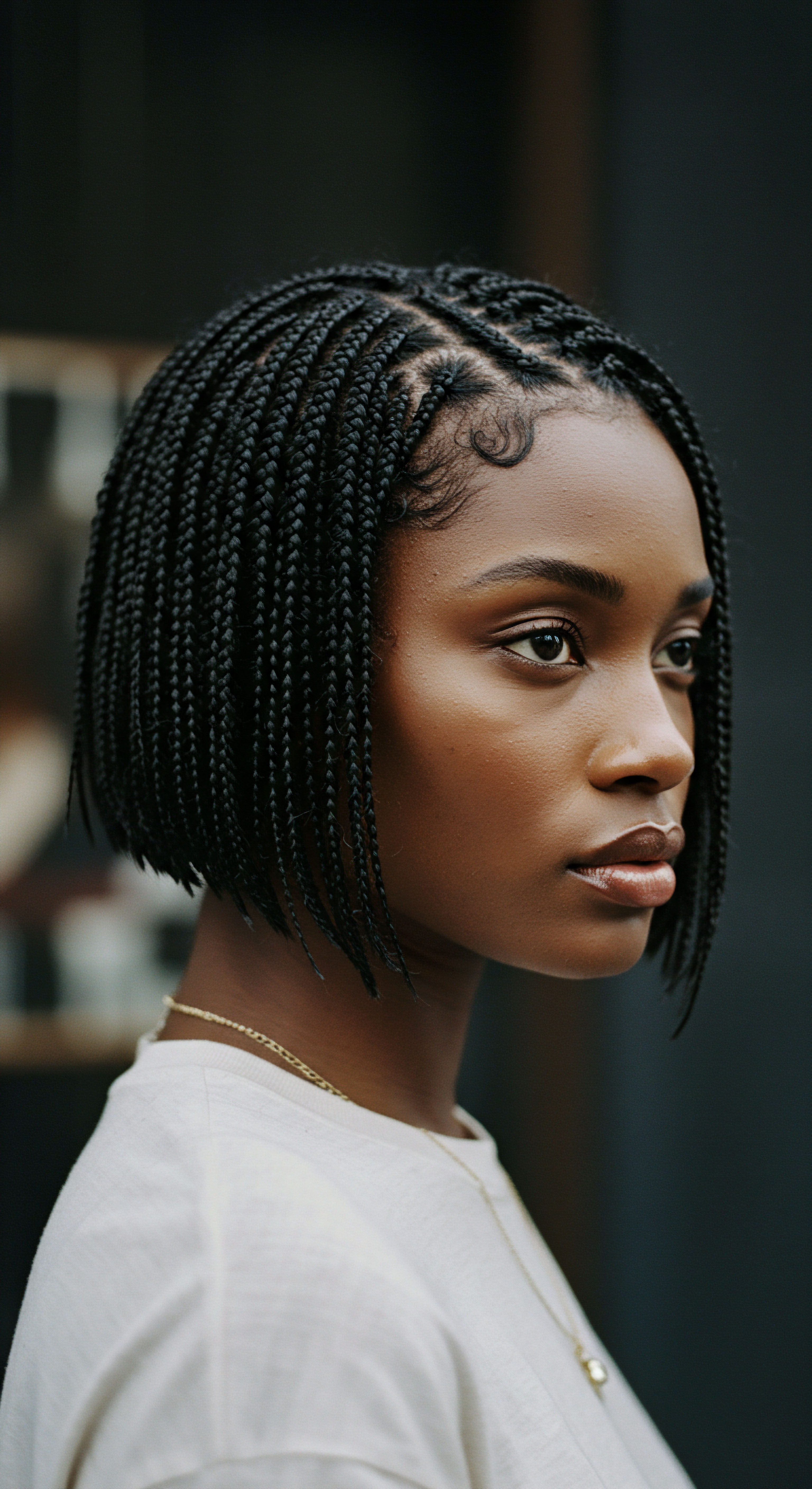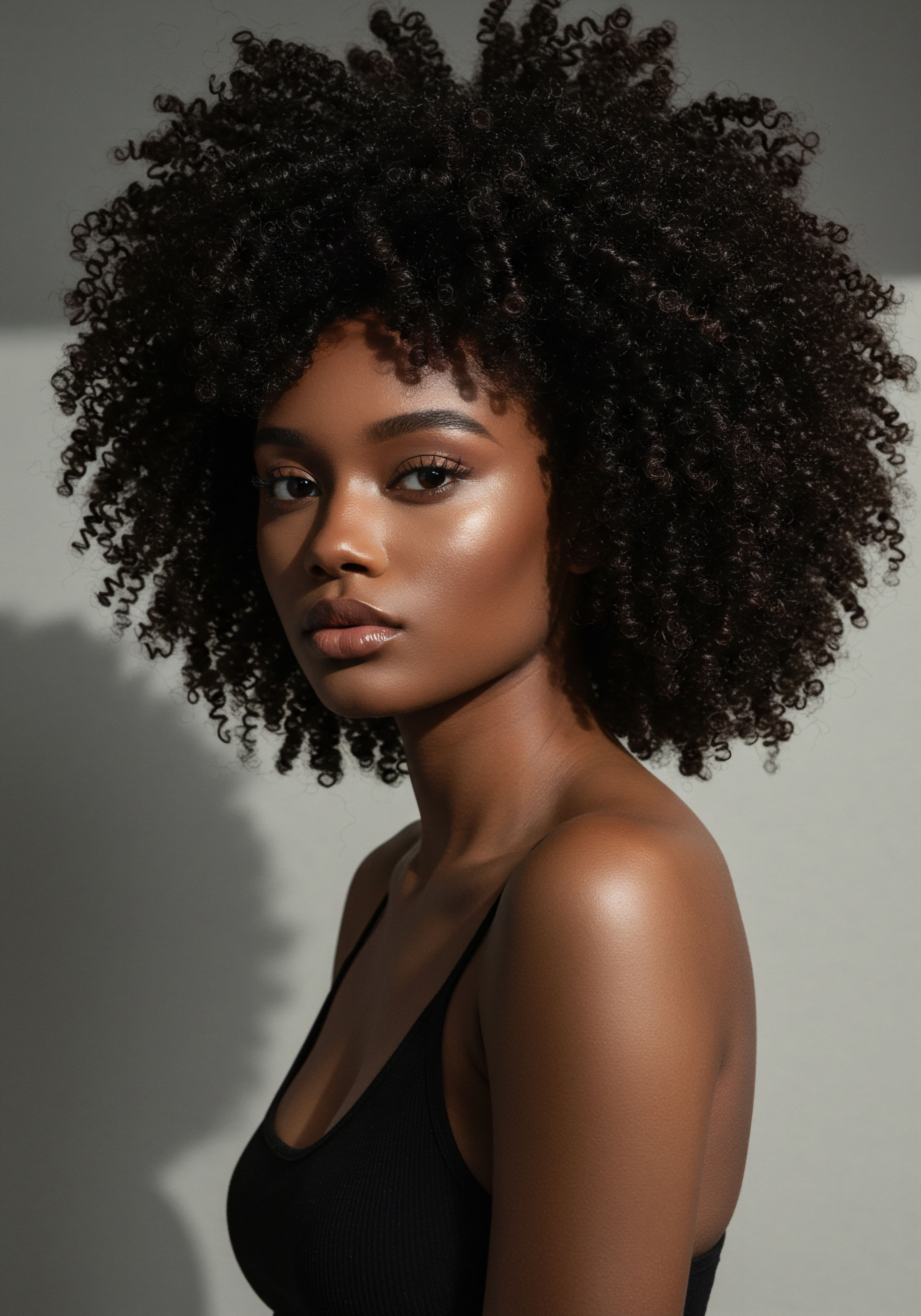
Roots
As dusk settles and the world quiets, a quiet, almost imperceptible shift occurs within us, a turning inward as the day’s clamor fades. This nightly transition, centuries old, once held profound implications for how people cared for their hair, particularly for keeping it clean. We carry within our collective memory the whispers of ancient practices, echoes of human ingenuity adapting to the rhythms of light and shadow, finding ways to preserve hair’s vitality even as sleep claimed their waking hours. This exploration reaches back to the very origins of these quiet routines, seeking to understand the fundamental approaches to hair cleanliness when modern conveniences were unimaginable.
The ancient perception of hair extended beyond mere adornment; it was often viewed as a living extension of the self, susceptible to environmental influences and requiring careful attention. The need to maintain hair’s condition, especially against the accumulation of daily dust, sweat, and environmental elements, was a constant consideration. Without the ready access to running water or the array of cleansing agents we know today, our ancestors developed ingenious methods, relying on nature’s offerings and the wisdom passed down through generations.

Ancient Hair’s Vulnerability at Night
Consider the daily existence of ancient peoples. Exposure to the elements, whether the desert sands of Egypt or the humid air of the Indus Valley, meant hair was constantly gathering particulate matter. Dust, smoke from cooking fires, and natural debris would cling to strands.
At night, as bodies rested, hair could become matted or tangled, potentially attracting insects or simply feeling uncomfortable. The goal of nighttime hair care was not just about cleanliness in a sterile sense, but also about comfort, preservation of style, and protection from pests.
The materials available shaped these early cleansing agents. Before manufactured soaps, natural substances with saponifying properties were employed. These could include plant extracts, certain clays, or even specific types of ash. The focus was less on lathering and more on absorption, gentle removal of impurities, and often, conditioning.
Ancient peoples devised resourceful ways to care for their hair overnight, driven by a desire for comfort and protection, adapting to available natural materials.

What Natural Cleansers Did Ancient People Use?
Many civilizations turned to the earth and its plant life for their hair hygiene.
- Clay ❉ Rhassoul clay, sourced from the Atlas Mountains of Morocco, was used in North Africa for centuries. Its ability to absorb oils and impurities without stripping hair made it a valued cleansing agent.
- Plant Extracts ❉ In the Indian subcontinent, the Bronze Age Indus Civilization (around 14th century BCE) created herbal pastes from boiled reetha (Indian soapberry), amla (gooseberry), hibiscus, and shikakai (acacia). These plants contain natural saponins, which create a mild lather and offer cleansing properties.
- Ash ❉ While less common for direct hair cleansing, ash from specific plants, when combined with water, could form a lye-like solution used for stronger cleaning, though likely more for textiles or very infrequent, deep hair washes.
- Citrus Juices and Vinegar ❉ Ancient Egyptians sometimes used citrus juice and water to cleanse their wigs, while Greeks and Romans applied vinegar rinses. The acidic nature of these liquids would help dissolve oils and leave hair feeling clean.
These methods speak to a profound understanding of natural chemistry, albeit without modern scientific nomenclature. The knowledge of which plants yielded cleansing properties, which oils offered conditioning, and which minerals could absorb impurities, was accumulated through generations of observation and practice. This foundational knowledge set the stage for more elaborate nighttime rituals.

Ritual
As the day concluded, ancient individuals engaged in quiet, often deeply personal practices to tend to their hair, a transition from the world’s bustle to the calm of slumber. These nightly routines were not simply about tidiness; they were about preserving styles, minimizing discomfort, and maintaining the overall health of their hair. The actions taken, whether simple or elaborate, represented a conscious decision to prepare the hair for the night, a quiet ritual performed in the glow of oil lamps or the soft light of the moon.
One of the most widely adopted practices across diverse cultures was the use of coverings. Head wraps, scarves, or specific sleeping caps served multiple purposes. They acted as a physical barrier against dust and environmental debris, preserving the cleanliness achieved during the day.
Beyond this practical aspect, they also helped to maintain elaborate hairstyles, preventing tangling and disruption during sleep. For cultures where hair held significant social or spiritual weight, such coverings were also a sign of respect and modesty.

Did Head Coverings Protect Ancient Hairstyles?
Indeed, protective coverings were a common feature of ancient nighttime hair care. In ancient Egypt, for instance, wealthy individuals often used wooden or ivory headrests, not soft pillows, to keep their elaborate coiffures from becoming disarranged. This seemingly uncomfortable solution highlights the immense value placed on preserving intricate styles, some of which were held in place with fatty ‘gels’ or beeswax.
| Culture Ancient Egypt |
| Common Covering Headrests, wigs, occasional wraps |
| Primary Purpose at Night Preserving styled hair and wigs, pest deterrence |
| Culture Medieval Europe |
| Common Covering Veils, caps, linen cloths |
| Primary Purpose at Night Absorbing oils, protecting from dust, modesty |
| Culture Various African Cultures |
| Common Covering Head wraps, scarves |
| Primary Purpose at Night Hair protection, moisture retention, cultural expression |
| Culture These coverings reflect a blend of practical hygiene, style preservation, and cultural significance across different eras. |
The practice of dry cleansing and the application of aromatic treatments were also significant. Without frequent water washes, absorbing excess oils and refreshing the hair became crucial. Powders made from ground herbs, scented clays, or even finely milled grains could be dusted onto the scalp and hair.
These powders would absorb sebum and dirt, and then be brushed out, taking impurities with them. This is strikingly similar to modern dry shampoo.
Nightly hair routines in antiquity prioritized preservation of style and hygiene through protective coverings and dry cleansing methods.

How Did Dry Cleansing Work in Ancient Times?
Dry cleansing involved several steps, often performed as a routine before sleep.
- Powder Application ❉ Fine powders, often scented with herbs or resins, were applied to the hair and scalp. These would cling to oils and loose dirt.
- Vigorous Brushing ❉ Following powder application, or even as a standalone practice, extensive brushing with combs and brushes was essential. This action would distribute natural oils from the scalp down the hair shaft, preventing excessive oiliness at the roots and dryness at the ends. It also physically removed the applied powders and any absorbed impurities.
- Aromatic Cones ❉ In ancient Sumeria, women would place small cones of perfume on their heads that would gradually melt, keeping their hair aromatic throughout the day and likely into the night.
The effectiveness of brushing as a cleaning method is well-documented. Katherine Haircare, a resource on historical hair care, notes that Victorian and Edwardian women relied heavily on brushing their hair every night with boar bristle brushes to mechanically clean hair of debris, distribute scalp oils, and detangle. This method, rooted in much older practices, shows how consistent mechanical action could substitute for frequent water washing.
A particularly compelling example of ancient hair treatment, one that highlights the intersection of beauty and preservation, comes from archaeological discoveries in ancient Egypt. Analysis of mummified hair samples, some dating back 3,500 years, revealed that ancient Egyptians used a fat-based ‘gel’ to style their hair. Researchers found this substance, composed of biological long-chain fatty acids like palmitic and stearic acid, on the hair of both naturally and artificially preserved mummies.
This suggests the product was used in life to set hairstyles and was considered so vital that it was also applied as part of the mummification process to keep the deceased’s hair looking coiffured into the afterlife. This finding challenges a modern assumption that hair care was purely about active cleansing, revealing a dimension of styling and preservation that extended beyond the waking hours, even into eternity.

Relay
To truly comprehend how ancient people maintained hair cleanliness through the night, we must consider the intricate interplay of biological understanding, environmental conditions, and the profound cultural meanings ascribed to hair. It extends beyond simple actions to a complex web of knowledge, necessity, and belief systems that shaped daily existence. This deeper exploration asks us to peer into the less apparent scientific underpinnings and the societal motivations that drove these nocturnal hair rituals.
While ancient civilizations certainly lacked microscopes and knowledge of microbial life, their practices often had beneficial, albeit unintended, hygienic outcomes. The environmental context played a colossal part. In arid climates, for instance, excessive washing could strip hair of essential moisture, making oiling and dry cleansing more practical and beneficial. The dry air itself acted as a natural desiccant, helping to keep hair from becoming overly greasy or prone to bacterial growth that thrives in damp conditions.

How Did Environment Influence Ancient Hair Care?
The natural surroundings dictated the available resources and the challenges faced.
- Arid Climates ❉ In regions like ancient Egypt and Mesopotamia, the dry air meant less humidity-induced frizz and faster evaporation of sweat. Oils were crucial for moisturizing and protecting hair from desiccation.
- Humid Climates ❉ In areas like the Indian subcontinent, where humidity was higher, practices like oiling followed by herbal washes would help manage oiliness and maintain scalp health.
- Resource Availability ❉ The plants and minerals indigenous to a region directly influenced the ingredients used for cleansing and conditioning. Yucca root in the Americas, rhassoul clay in North Africa, and specific herbs in India each served a similar purpose, adapted to local flora.
The chemical properties of the natural ingredients used were surprisingly effective. Oils like olive, coconut, castor, and almond were not just emollients; many possess antimicrobial and anti-inflammatory properties. For instance, castor oil, used in ancient Egypt, contains ricinoleic acid, known for its anti-inflammatory and antimicrobial effects, which contribute to a healthy scalp. This suggests that even without knowing the precise molecular mechanisms, ancient peoples observed the beneficial effects of these substances on scalp health and hair condition.

What Was the Science Behind Ancient Hair Preparations?
The efficacy of ancient hair preparations rested on their inherent chemical makeup.
| Ingredient Olive Oil |
| Key Properties Monounsaturated fats, antioxidants, Vitamin E |
| Relevance to Nighttime Cleanliness Nourishes scalp, prevents dryness, helps distribute sebum, potentially reduces microbial growth. |
| Ingredient Coconut Oil |
| Key Properties Lauric acid, medium-chain fatty acids |
| Relevance to Nighttime Cleanliness Deep moisturization, protein loss prevention, antimicrobial action, good for scalp health. |
| Ingredient Rhassoul Clay |
| Key Properties High mineral content (silica, magnesium, calcium) |
| Relevance to Nighttime Cleanliness Absorbs excess oil and impurities, gentle cleansing without stripping. |
| Ingredient Herbal Saponins (e.g. Shikakai, Reetha) |
| Key Properties Natural surfactants |
| Relevance to Nighttime Cleanliness Mild cleansing action, removes dirt and oil, conditions hair. |
| Ingredient These natural elements provided cleansing, conditioning, and protective benefits, aligning with intuitive understanding of hair well-being. |
The cultural significance of hair often meant that nighttime care was more than a practical chore; it was a revered practice. In many societies, hair length, style, and condition were direct indicators of social status, marital status, or even spiritual devotion. Maintaining these aspects, even during sleep, was paramount.
For example, in ancient Greece, an uncovered woman’s hair could be seen with the same emotional intensity as a bare breast, highlighting the profound cultural weight placed on hair and its presentation. This underscores why protective nighttime measures were not merely about physical cleanliness but about preserving identity and societal standing.
The scientific properties of natural ingredients, combined with the cultural significance of hair, shaped ancient nighttime hair care practices beyond simple hygiene.
Archaeological findings continue to provide tangible evidence of these ancient routines. Beyond the Egyptian hair gel, consider the broader evidence of ancient tools. Decorative combs, some dating back to 3900 BCE in Egyptian women’s tombs, were not just for styling but for detangling and likely for distributing oils and powders. These combs, with their fine teeth, would have been highly effective at removing debris and even pests, a practice still used today for lice removal.
This continuous, meticulous combing at night, a method often overlooked in modern discussions of ancient hygiene, played a significant part in keeping hair clean and healthy without daily water washing. A study of Medieval hair care practices suggests that thorough brushing and combing twice a day was the biggest part of their routine, distributing natural oils and exfoliating the scalp, effectively cleaning and conditioning simultaneously. This highlights a powerful, less celebrated aspect of ancient nighttime hygiene ❉ mechanical cleaning.
The ancient world’s approach to hair cleanliness at night was a sophisticated blend of observation, resourcefulness, and cultural imperative. They did not have our modern scientific lexicon, yet their practices aligned with principles of absorption, mechanical removal, and natural conditioning. The quiet moments before sleep were not just for rest, but for a deliberate, gentle tending to the hair, ensuring its continued beauty and health in a world without synthetic solutions.

Reflection
As we journey back through the quiet nights of ancient civilizations, a profound realization dawns ❉ the quest for clean, well-cared-for hair is a timeless human endeavor. Our ancestors, lacking the myriad of products and running water we take for granted, demonstrated remarkable ingenuity and a deep connection to their natural surroundings. Their nightly routines, whether involving a simple protective wrap, the meticulous application of plant-based oils, or the rhythmic sweep of a comb, were not merely acts of hygiene but expressions of respect for their bodies and their place in the world.
The echoes of these practices resonate still, reminding us that true hair wellness often returns to fundamental principles of gentle care, nourishment, and protection. Perhaps there is a quiet wisdom to be found in those ancient shadows, a gentle reminder that sometimes, the simplest acts, performed with intention, hold the most enduring power for our hair’s well-being.

References
- McCreesh, N. Gize, A. & Rigby, A. (2011). The use of hair styling products in ancient Egypt ❉ An archaeological and chemical study. Journal of Archaeological Science, 38(10), 2841-2846.
- Çay, H. (2023). Beauty Secrets and Recipes from Ancient Civilizations. Amazon.
- Ihoeghiana, N. A. & Akwaraa, E. (2020). Formulation, Evaluation, and Comparison of Herbal Shampoo with Marketed Synthetic Shampoos. NIPES Journal of Science and Technology Research, 3(4), 342–348.
- Massey, P. T. (2020). Female Beauty and Male Attraction in Ancient Greece. Cambridge Scholars Publishing.
- The Anoo’s Sisters. (2010). Ancient Indian Beauty Secrets. AuthorHouse.
- Sorokina, T. S. (2020). Sanitary and hygienic regulations in Ancient civilizations. Global Prosperity.
- Stowell, L. (2017). The American Duchess Guide to 18th Century Beauty. F+W Media.
- Pointer, S. (2005). The Artifice of Beauty ❉ A History and Practical Guide to Ancient and Medieval Beauty. The History Press.
- Eldridge, L. (2015). Face Paint ❉ The Story of Makeup. Abrams Image.
- Cohen, D. (2016). Ashkenazi Herbalism ❉ Rediscovering the Herbal Traditions of Eastern European Jews. Inner Traditions.